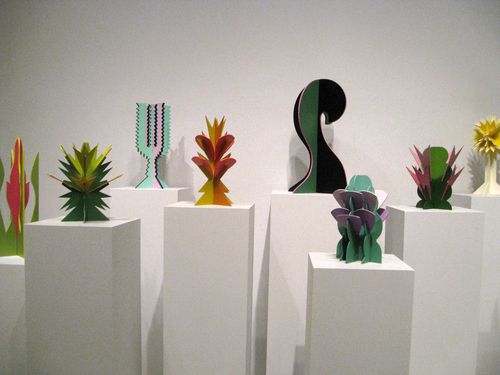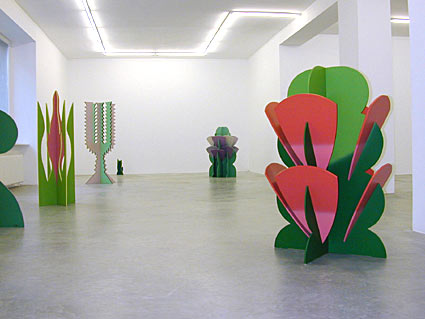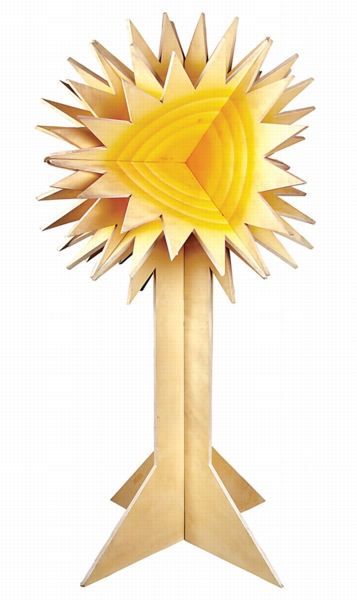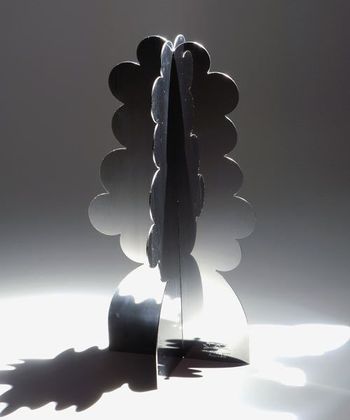
Giacomo Balla, Futurist Flowers, Hirshhorn Museum, image via artobserver
They’ve been on view at the Hirshhorn for most of the year, but it’s only in the last couple of visits that I’ve started wondering just what is up with Giacomo Balla’s Futurist Flowers?
I mean, I like them well enough; they’re even kind of great. Marinetti and Boccioni occupy a lot of the Futurist mindshare, because of iconic painting and sculpture respectively, but Balla’s no slouch. If anything, his stage sets and fashion and furniture–and these and his other sculptures–make him the populist Futurist. The trendy one. And of course, he is the one who named is daughters Elica [Propeller] and Luce [Light].

“Il Giardini Futurista,” installation view, at Galerie Nordenhake in Berlin, 2003
So it’s not necessarily the concept behind Fiore Futurista, or the bigger project, Il Gardino Futurista, which seems to have occupied Balla’s attention for most of a decade following WWI, sort of a second wave Futurism. Which even gets its own manifesto
It’s literally these objects, these flowers, which were made, not in 1918, but in 1968, ten years after Balla’s own death. It was Balla’s daughters who authorized dealer Gaspero del Corso and his Galleria dell’Obelisco to produce painted wood editions of their father’s various Fiore Futurista designs. These were based on actual, existing sculptures, paper models left in Balla’s studio after his death, and possibly photodocumentation of lost flowers There were at least two sizes: human-scale and tabletop size, in editions of 40.
Curator Anne Ellegood told the Smithsonian Magazine that Joseph Hirshhorn–who, remember that inner hallway, had a real thing for tabletop sculpture–bought a complete set of smaller Fiori in 1969.

And I suppose you could, too. Futurist Flowers turn up for sale occasionally, though maybe not as frequently as their numbers might suggest. A big one, Fiore Grande D sort of shaped like a truffula tree, in pretty rough condition, didn’t sell at Doyle last year, even with just an $800-1200 estimate.
Which, if they’re not really valuable, and they’re not rare, then what was the point? Were Balla’s daughters operating under similar motivations as Degas’ heirs, who set about casting posthumous bronze editions of all the wax maquettes left in the studio?
My own theory is bolstered by this timeline item in the Galleria dell’Obelisco archive: “1968: Rediscovering Giacomo Balla and Futurism.”
It’s easy to forget that our art history hasn’t been static, and that there might have been a time when Futurism needed rediscovering. And it can be hard on estates when an artist swings back into critical fashion, but there’s no merch to support or engage the new attention. Just ask the Smithson people.
So maybe Balla’s Fiori were a way of not just presenting these key ideas and objects anew, but in propagating them, in getting them out there, to be shown, and seen.

None of which explains Dino Gavina, though; these chrome Fiore, created as early as 1969 in editions of 400, seem like good, old-fashioned capitalism at work.
Skip to content
the making of, by greg allen
